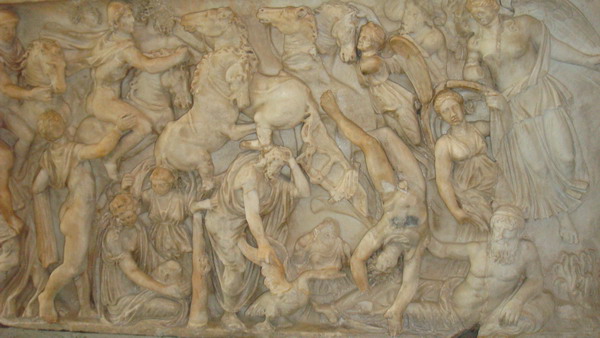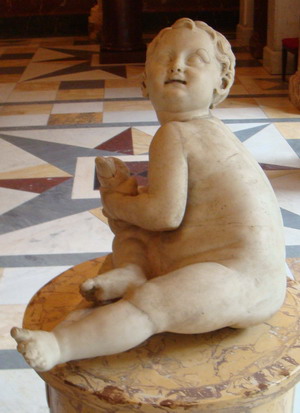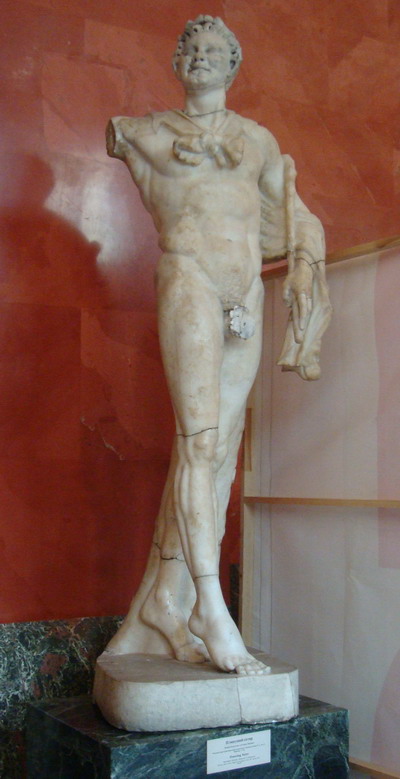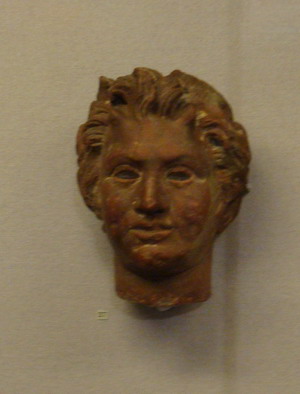On April 8-10, 2010 I went on affairs to Sankt-Petersburg. Has considered as the debt to descend in the Hermitage, has grasped with itself the camera and has bought the ticket for photographing.
In the Hermitage one of the best collections in the world of original samples of an ancient art, including artifacts from Ancient Greece, Rome and Bosporus empires is collected. Not philosophizing crafty, I began to bypass halls with Roman, Greek and Bosporus exhibits as they are in one part of the Winter Palace and one settle down behind others. I photographed all successively, except for several world famous statues of gods and busts of emperors.
Below my photographic report on excursion in the past is resulted.
I some years carry out researches in the field of a history and I reconstruct events without a binding on the political, religious both standard canons and stereotypes. In halls of the Hermitage I have received a full set of the proofs confirming my reconstruction of a history which essence consists in existence of a uniform vector of development and moving of a human civilization from region of the Volga region worldwide.
Obstinate thing and they speak the facts that in a reality never existed weights of people of a fine, Arias exterior neither in Ancient Greece, nor in Rome. Among millions unsightly ancient hominids there were separate persons who can be counted beautiful people of the European exterior. These small people looked as Arias; the others were grey weight of prototypes of modern people.
And all beautiful Arias, both men, and women represented either gods, or a sort of tsars and their relatives. We know, that them was for thousand years of all a little сот the person. Thus the western civilization has inspired us, that all Romans and Hellenes were similar to gods, persons of them were fine, and figures of athletic addition. The Renaissance in Europe in XVI-XVII centuries has created numerous samples of imitations of ancient art. In them classical images of ancient people which molded are embodied or wrote from the models living among authors of products. Late artists and sculptors XVIII-XX of centuries also have made considerable efforts, representing in the products "ancient" Hellenes and Romans in turn to embellish creations of the Renaissance. In result to continuous work of Masonic masters for 500 years we today think, that ancient people were divine, and the European culture and a civilization has left areas of Greece and Italy. Jacobs all best samples of art have been made West Europeans in a counterbalance to the dirty, dirty, terrible and wild East including territory of modern Russia.
Actually it is the bald lie and mystification. The modern civilization was distributed from territory of Russia from regions of the Volga region, Caucasus and Altai – all ancestors of ancient Greeks and Romans there from it came. Ancient Rome settled down in area of settlement Selitornoe on Volga-Akhtuba. The population of ancient city named it on Bulgarian language is Idel, in Latin language is Rome, and in the Egyptian and Greek languages is Memphis. The river Tiber is the Latin name of the river Akhtuba, from word a tuba (pipe, the channel). Arms of Idel and Rome were wolf female (look clause "Lupa Capitolina from Volga region"). There lived the seven ancient tribes originating in seven foremothers, and the city lay on seven hills. The urban population was Mongolian-Bulgarian exteriors. The Mega police settled down on crossing caravans and sea ways of the West and the east, the north and the south. From the Volga region people came in the Mediterranean region, having based a civilization of the Greek cities – colonies. Ancient Greeks also were Mongolian-Bulgarian exteriors. Only the elite of Greeks and Romans looked, as modern Europeans. The elite were headed with a sort of tsars of Russia which on Bulgarian language referred to the Dulo. In due course elite assimilated the population which began to get features Aries.
In II-I centuries B.C. and in the first centuries of our era Romans from Volga-Akhtuba have carried out expansion on the West, leaning to the aid related tribes Etruscans in Italy and the Greek cities – colonies at coast of the seas. In IV century of our era Rome has been seized by the Egyptian dynasty of Pharaohs of the New Empire based by Roman emperors Gordian’s, it come from Africa. In 324 Rome has fallen under impacts of armies of Pharaoh Tutmoses III, descendant Gordian’s. In 378-379 from Rome the first wave of immigrants named in the European historiography first Hun the invasion left. Refugees have headed Flavius Theodosius, becoming emperor of New Rome Theodosius Great. Bulgarian name of emperor was Arbat, and it was tsar of a dynasty the Russ-Dulo or Hon dynasties. Hon or Hun in fact was ancient Romans. At resettlement they have grasped with themselves samples of the culture, a work of art and jewelry. These subjects have been transferred from Volga-Akhtuba to Europe, Balkans and Italy.
The second wave of immigrants of ancient Rome has moved to Europe in V century in 440-450. This time refugee’s grandson Flavius Theodosius by name Flavius Aetius has headed received title of emperor with name Theodosius II. Flavius Aetius it anybody other, as legendary Attila, the next tsar from sort of Russ-Dulo is Hon dynasty. The second "Hun" invasion also has transferred weight of artifacts and subjects of art from Ancient Rome to Europe. Romans (ostensibly Hun) again have devastated Europe, having shown miracles of cruelty and barbarity. After Flavius Aetius, named «Last Roman», or Attila on Bulgarian, anybody is more in a history failed similar grandiose resettlements of peoples.
In such plain image subjects of art of Rome have got to Europe, including on territory of northern and southern Italy. In the center of Italy was Etruria – the state of Etruscans which had the original art similar on Ancient Rome from Volga-Akhtuba. Only in XIII-XV centuries the grandiose project of Catholic Church and the western freemasonry on creation of imitation of Ancient Rome in the center of Italy on a place of ancient settlement Etruscans has been carried out. This Rome exists till now, being capital of Italy.
The history of ancient city – capitals of the world – Idel, Rome, Memphis, Mitsraim on it has not ended. In VII century ancient Bulgarian they Israelis have finally expelled pharaohs from Volga-Akhtuba, and by the end of a century Memphis again has found the ancient name – Itil. In due course Itil became capital powerful Khasar Khaganate. In 965-969 Russian Grand Prince Svyatoslav Rurikovich with the help of an army of Vikings and Romans with wall bit machines and special arms have grasped Itil. Khazar Khaganate has been destroyed. In XIII century Itil has received a new life and the name – Saray-Batu becoming one capitals of Golden Horde. At last in XVI century tsar Ivan Terrible has finally destroyed the Saray-Batu, having disassembled his constructions and a wall. From the received building material Astrakhan has been erected. During destruction the length of walls of the Asian part of city made the Saray-Batu about 18 km at width of sector 8 of km, and on island Akhtuba the length of walls was about 12 km and width of sector 6 of km. Actually ancient city in the sizes did not concede the Saray-Batu to modern Moscow. Long millennia in Idel-Rome-Memphis-Mitsraim-Itil-Saray-Batu lived from 600 000 up to one million person. Ruins of city are grandiose pantry of a history, culture and religion. Masonic scientists diligently avoid carrying out there scale excavation. In those places prospers only black selector of treasures.
How long it is possible to hide to world elite of impostors true from people?
20-22.04.2010.
1. A fragment of the Roman sarcophagus with heads at corners I-II century
Pay attention to severity of a composition and the refined poses of figures. Thus look at the men represented on corners of a sarcophagus is Mongolian-Bulgarian persons.
2. The Roman sarcophagus II century
Also a beautiful composition in classical style, however, we shall look narrowly at persons of Romans on a sarcophagus and to an abundance of horses in Rome.
3. A cover of Roman sarcophagus I century
A severe Roman composition on a wall of a sarcophagus. Look closely on round Mongolian-Bulgarian persons of angels, and also their large bodies without a waist and necks.
4. A cover of the Roman sarcophagus II century
Other refined wall of the Roman sarcophagus. Look at the Mongolian persons and a body of angels and women.
9. A fragment of Roman altar I century
The Mongolian person of a Jellyfish – Gorgonian from the Roman altar.
10. A wall of a sarcophagus, Rome, I century
Mongolian-Bulgarian an angel in all Roman beauty – the round person, a large body without a waist, short legs.
16. The Roman child
The lovely Roman boy with Mongolian-Bulgarian appearance.
18. Roman satires
Roman satires with a body of the athlete and the Mongolian person
19. One of the Roman goddesses
The Roman goddess, despite of an Aries origin, is surprisingly similar on large Bulgarian the woman.
27. The Roman goddess
One of the Roman goddesses – Mongolian-Bulgarian the woman.
30. Carter, Italy, IV century B.C.
Carter Romans – peer closely into round Mongolian persons on handles of a vessel.
41. The Greek terracottas, VI-I centuries B.C. 9
Greek the man – whether the Mongol, whether Bulgarian.
42. A terracotta, Bosporus, IV-I century B.C.
The lovely girl with Bosporus empires – the crafty Mongolian-Slavic person.
Source: http://www.kubarev.ru/en/content/273.htm













No comments:
Post a Comment